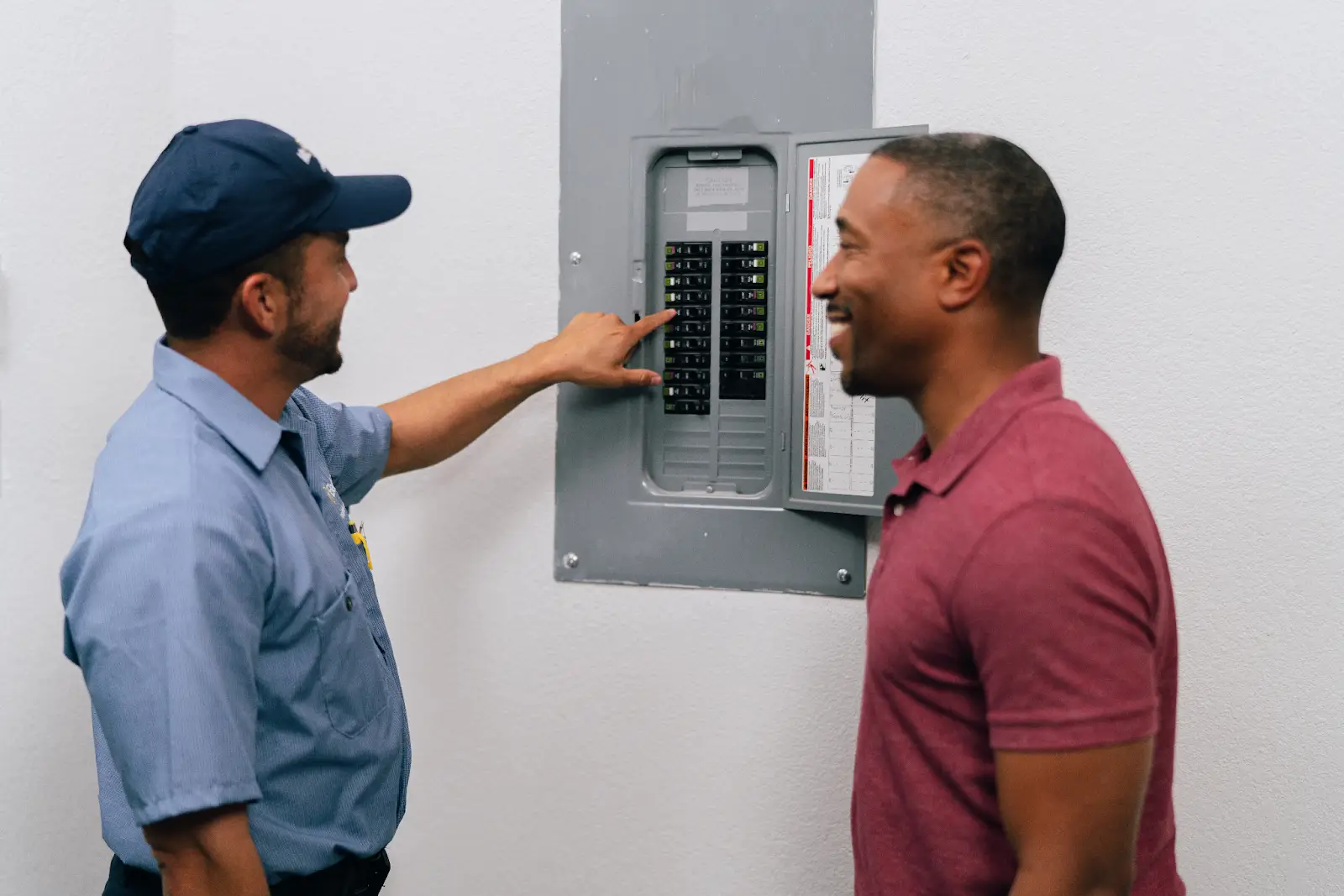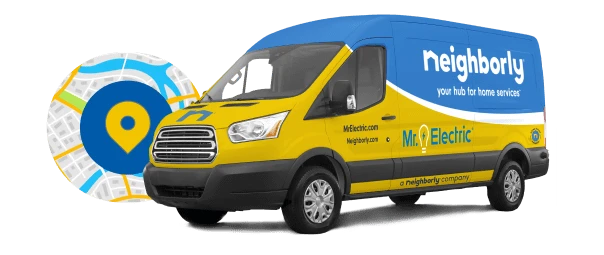
Mr. Electric recommends these steps to restore power safely when your circuit breaker trips.
|
If your power suddenly goes out during a storm or a period of heavy power usage, a tripped breaker is the likely culprit. The simplest way to restore power when your breaker trips is to unplug appliances and reset the breaker.
This article explains how to fix a tripped breaker safely, common causes of tripped circuit breakers, and when it’s time to call in the pros.
What Is a Tripped Breaker, and Why Does It Happen?
A tripped circuit breaker is a failsafe designed to prevent excess current from entering your home’s wiring. Your breaker panel is designed to cut off electricity when it detects:
- An overload (too many devices drawing power)
- A short circuit (a hot wire touches a neutral or ground wire)
- A ground fault (current escapes to a grounded surface)
In other words, the circuit breaker interrupts the flow of electricity to prevent overheating, fires, or damage to appliances. To learn more about how your circuit breakers work, read our easy guide to understanding your breaker panel.
Signs that your breaker tripped
A sudden loss of power is the clearest sign of a tripped circuit breaker (or breakers). While power grid outages cannot be resolved from your electrical panel, the following instances usually can:
- A portion of your home suddenly loses power
- High-wattage appliances won’t turn on
- Lights flicker before going dark
- A switch in your breaker box in the “OFF” or middle position
Step-by-Step: How to Fix a Tripped Breaker

Resetting a tripped breaker is easier than you might think. Here’s how to fix a tripped breaker safely:
- Turn off devices on the affected circuit. Unplug any appliances and turn off lights or electronics that have lost power. This crucial step prevents a power surge when the breaker resets.
- Locate your breaker box. Breaker boxes are typically gray metal panels located in basements, laundry rooms, closets, or garages.
- Avoid damp areas. Since water and electricity don’t mix, never approach a circuit breaker if the area is wet. Wait for the area to dry, or call a professional to ensure it’s safe.
- Locate the tripped breaker. Open your panel and look for a breaker that’s not fully in the “ON” position. A tripped breaker will usually sit in the middle or “OFF” position. Many circuit breakers display a red or orange color when they’ve been tripped.
- Flip the breaker fully to OFF. Before you turn the circuit breaker back on, make sure it’s fully switched to the “OFF” position first. This resets the internal mechanism.
- Turn the breaker back ON. Firmly push the switch to the “ON” position. It should give slight resistance and make a distinct click sound. If it stays in place, test a low-wattage device in the affected area.
What If the Circuit Breaker Trips Again?
If your circuit breaker trips repeatedly or doesn’t stay in place after a reset, it could indicate a more serious electrical issue.
Possible causes of a breaker that keeps tripping include:
- Overloaded circuits: Too many devices on one line
- Faulty appliances: A damaged device drawing excessive power
- Wiring issues: Frayed or exposed wires inside the walls
- Aging electrical panels: Older systems may no longer handle modern electrical loads
If the problem persists, you may need to replace the circuit breaker.
When to call a professional for a tripped breaker
While flipping a breaker is usually safe, recurring issues require expert attention. Call a qualified electrician if:
- The same breaker trips more than once a week
- You smell burning near the panel
- You see visible damage on breakers or outlets
- You hear buzzing from the breaker panel
- The breaker won’t reset or trips immediately after flipping
Never force a breaker to stay on. It’s trying to protect you—listen to it.
Get Expert Help from Your Local Mr. Electric Team
Learning how to flip a breaker and recognize the signs of a tripped circuit breaker are basic but essential homeowner skills. Understanding your electrical system can empower you to make safe choices and avoid stress when the power goes out.
While resetting a tripped breaker is typically safe and simple, ongoing issues should never be ignored. When in doubt, contact a trusted local electrician.
Your local Mr. Electric® team provides trusted diagnostics, repairs, and panel upgrades in your area. If you’re struggling with how to fix a tripped breaker, request an appointment with our helpful service professionals. Learn more about our circuit breaker installation services and electrical safety inspections, all backed by the Neighborly Done Right Promise® to ensure your satisfaction.
This article is intended for general guidance only and is not applicable to every situation. You are responsible for determining the proper course of action for your property and situation. Mr. Electric is not responsible for any damages that occur as a result of advice and/or guidance derived from its blog content.
FAQs About Tripped Circuit Breakers
The safety of you, your family, and your home are the top priority of every Mr. Electric service professional. Our safety-first commitment to solving your electrical issues includes a meticulous attention to detail on every job. Our commitment also includes using our years of experience to answer your questions. Below are answers to some of the most frequently asked questions about what to do when a breaker trips.
How do I know if a breaker tripped or if it’s something else?
A tripped breaker typically looks out of line compared to the active breakers. Check your breaker panel for a switch that is:
- Turned to the OFF position.
- Sitting between ON and OFF
- Showing red or orange coloring
If resetting the switch restores power, you’ve found the issue.
How to fix a tripped breaker that won’t reset?
Follow these steps if a breaker won’t reset:
- Use the circuit map on the breaker panel to identify which room, zone, or appliance the tripped breaker controls.
- Turn off or unplug everything on the circuit.
- Flip the breaker to OFF and then ON.
If the breaker immediately trips again, there may be a wiring problem, a short circuit, or a faulty breaker. Call a qualified electrician to inspect further.
Why does my circuit breaker trip every time I plug something in?
A circuit breaker that constantly trips suggests an overloaded or shorted circuit. The circuit breaker trips to prevent damage or fire, so don’t try to keep it from flipping. Never tape a breaker in place! Stop using the outlet until a professional can assess the situation.
Is it safe to turn a circuit breaker back on myself?
Yes, in most cases, homeowners can safely turn on a tripped circuit breaker. Follow proper precautions: ensure the area is dry, unplug appliances on the affected circuit, and flip the breaker fully to the OFF position before flipping back to ON.
If the breaker trips again or won’t stay on, contact a qualified electrician.
How do I prevent a breaker from tripping in the first place?
Follow these steps to avoid future tripped breakers:
- Don’t overload circuits. Avoid plugging too many high-wattage appliances (like space heaters, air fryers, or hairdryers) into a single outlet or power strip.
- Upgrade outdated panels. Older homes often have panels that can’t keep up with modern demands. Upgrading ensures safer, more efficient power distribution.
- Install dedicated circuits. Laundry rooms, HVAC units, and other high-wattage areas and appliances should each have their own circuits to prevent overload.
- Regular electrical inspections. Preventative checkups by a qualified electrician can catch worn wiring, loose connections, and overloaded circuits before they cause a breaker to trip.

